As Earth Day approaches, it’s the perfect opportunity for marketers to explore innovative ways to engage with eco-conscious customers. With a strong and growing interest in sustainable business practices worldwide, green audiences are becoming increasingly influential. In addition to being good for the planet, engaging these customers is great for any brand or organization striving to become more eco-friendly and socially responsible. By taking advantage of this timely event and using appropriate tools, you can create personalized campaigns that will both promote your brand and increase customer loyalty.
Eco-conscious audiences
In this blog post, we’ll cover three eco-conscious audiences to target this Earth Day:
- Solar energy
- GreenAwareTM
- Electric vehicles
Solar energy
Our first eco-conscious audience is Solar energy. Consumers in this audience show an inclination toward harnessing the power of the sun as a clean, renewable energy source. Our audience data can provide valuable insights into the Solar energy consumer base, including their age, education level, occupation, household income, and communication preferences. Let’s explore these metrics to better understand how to reach this group effectively.
Age and living situation
Consumers in our Solar energy audience are more likely to live in a home with two or more adults and are between the ages of 45-74.

Education level and occupation
Consumers in our Solar energy audience are more likely to have graduated from college or graduate school and work in management-level occupations.

Household income
Consumers in our Solar energy audience have household incomes of more than $75,000 and their homes are valued at over $550,000.

Preferred engagement channels
Consumers in our Solar energy audience are most receptive to ads served through digital channels like digital newspapers and email.

Solar energy audience pairings
Consumers in our Solar energy audience also belong to three of our Mosaic® USA groups:
- Power Elite
- Flourishing Families
- Booming with Confidence
Our consumer segmentation portal of 126 million households and 650 lifestyle and interest attributes empowers marketers like you to precisely target your ideal audience and communicate with them on a personal level. Mosaic’s data segments the U.S. into 19 overarching groups and 71 underlying types, giving you the insights needed to anticipate the behavior, attitudes, and preferences of your most profitable customers and communicate with them on their preferred channels, with messaging that resonates.
GreenAware
Our second eco-conscious audience is GreenAware.
GreenAware segments the 126 million U.S. households within Experian Marketing Data into four distinct groups. Each group differs in their attitudes and behaviors toward purchasing products that are environmentally safe and working with companies that are eco-conscious. We created these groups using an enhanced application of traditional statistical clustering techniques based on environmentally relevant measurements in Simmons’ National Consumer Study.
Based on the distinctive mindset of consumers toward the environment, you can learn how environmental concerns fit into their lives through four major consumer segments:
- Eco-Friendly Enthusiasts
- Sustainable Spectators
- Passive Greenies
- Eco Critics
Let’s dive deeper into each group to understand their unique perspective on the environment and how this impacts their attitudes and behaviors.
Eco-Friendly Enthusiasts
This eco-conscious segment prioritizes a green lifestyle and takes pride in avoiding products that harm the planet. With traditional and liberal values, they embrace optimism and prioritize family. With their children out of the house, they take the time for some well-deserved rejuvenation and are committed to a healthy lifestyle. Some members of this group are transitioning into retirement and welcoming a new chapter in their life.
- Mature adults and retirees
- College graduate or more
- Above average income
- May be married or single
- Typically own their homes
Sustainable Spectators
This segment aspires to be more sustainable, but they struggle with translating their green ideas into action. They have a soft spot for a cozy home. While their love for interior design and taking care of their own space is evident, they’re always looking for new experiences and opportunities to learn. Staying healthy and active is a top priority for this group, so it’s no surprise that they’re always looking for ways to stay fit and feel their best.
- Established and mid-life adults
- College graduate or more
- High income
- Typically married
- Likely to own their homes
Passive Greenies
This is the largest and one of the most youthful groups. Known for their love of exploration and self-discovery, they may not have fully embraced eco-conscious behaviors yet, but they are eager to stay current with the latest technology and trends. With their incredible ability to multitask, they’re always on-the-go, and constantly seek the next best thing.
- Mainly young adults and diverse
- Education ranges from high school through some college
- Below average income
- More likely to be single or divorced
- Typically rent
Eco Critics
This group is not likely to be eco-conscious and may have negative attitudes about the environment. They are confident, driven, and focused on their personal growth. They crave instant gratification, seeking out quick and easy solutions to their everyday decisions. They place a high value on entertainment, their social life, and carefully curate their image.
- Young and established adults
- Education ranges from high school through post-graduate studies
- High income
- Married or single
- Typically own their homes
Let’s take a look at how the GreenAware segments stack up against each other in terms of age, household income, education level, and media preference. How do they compare? Let’s find out.
Age
Consumers in the Eco-Friendly Enthusiasts segment are the oldest of the four GreenAware segments – about half of the consumers are 65 or older. Eco Critics are the youngest segment, with over half of consumers in this group between ages 25-44.
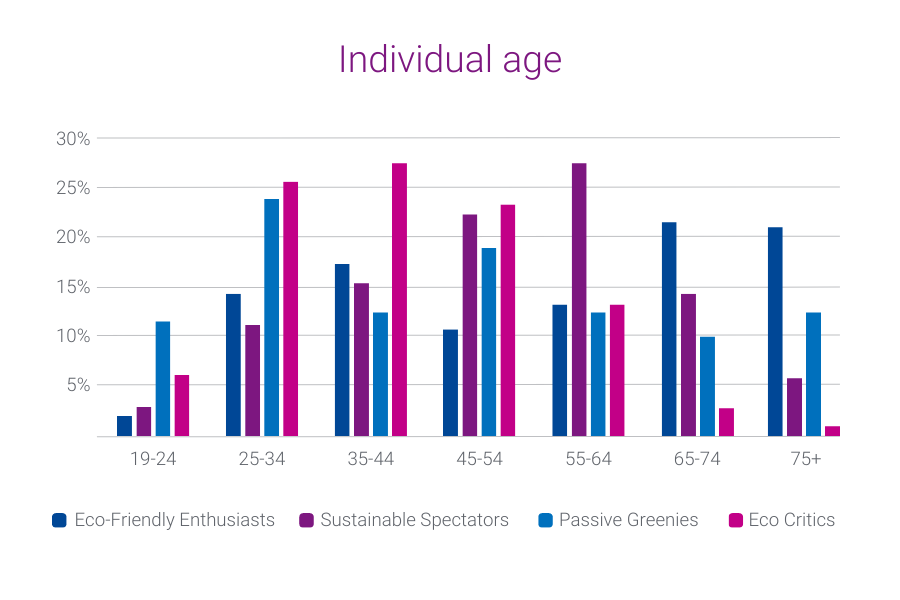
Household income
Sustainable Spectators and Eco Critics are the wealthiest GreenAware segments. The average household income of consumers in these segments is above $100,000. Passive Greenies have the lowest household income, with a majority below $50,000.

Education level and occupation
Passive Greenies are more likely to work Blue Collar jobs and have the lowest level of education. As the wealthiest segments, Sustainable Spectators and Eco Critics have the highest levels of college degrees and work in management, business, and financial operations. Eco-Friendly Enthusiasts are the most likely to be retired and out of the workforce.

Preferred engagement channels
- Streaming TV is the preferred engagement channel for all GreenAware segments.
- Eco-Friendly Enthusiasts prefer digital channels like digital newspapers, mobile SMS, and email. They also engage with traditional channels like direct mail and newspaper.
- Passive Greenies have a high preference for digital display, mobile SMS, digital video, broadcast cable TV, and radio.
- Eco Critics have a high preference for digital channels like digital newspapers, mobile SMS, and digital display.
- Sustainable Spectators strongly prefer digital newspapers. They don’t show as strong of a preference for mobile SMS and digital display as Eco Critics and Passive Greenies.

GreenAware audience pairings
Six of our Mosaic groups have at least one GreenAware segment with 10% or more of the population. For more precise targeting, below are suggested Mosaic audiences you can pair with each GreenAware segment:
| Eco-Friendly Enthusiasts | Sustainable Spectators | Passive Greenies | Eco Critics |
| Booming with Confidence | Power Elite | Singles and Starters | Power Elite |
| Autumn Years | Booming with Confidence | Golden Year Guardians | Suburban Style |
| Golden Year Guardians | Singles and Starters |
Electric vehicles
Our third eco-conscious audience is electric vehicles.
Electric vehicles (EVs) are having a major moment in the automotive industry. This is no surprise given that new EV models are being released and an increasing number of charging stations are popping up around the country. As EVs become more prominent, it’s essential to stay up to date on relevant trends to make informed decisions about what lies ahead.
The demand for electric vehicles (EVs) is on the rise
Consumers are embracing the EV revolution, showing their desire for a cleaner, greener future. Automotive marketers are increasingly looking to reach in-market EV shoppers and current alternative fuel vehicle owners due to the growing availability of electric vehicles, improved infrastructure, and rising popularity. In 2022, EVs charged up the market and accounted for a remarkable 6% of new retail registrations.
While Tesla continues to dominate the EV market, Ford, Chevrolet, and Hyundai are starting to compete, each holding more than 3% of the market share of new retail EV registrations.
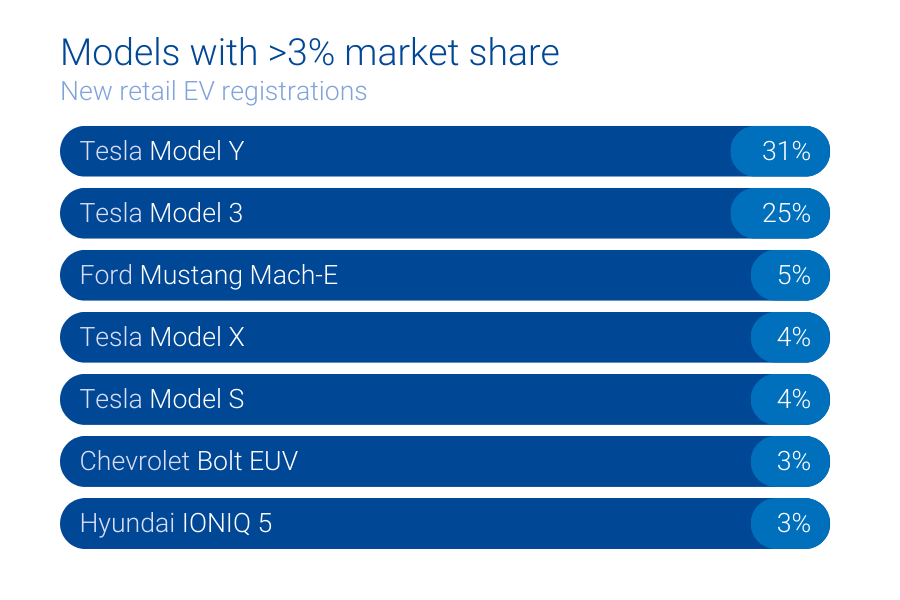
Geography
Where are we seeing the most new retail EV registrations? The top designated market areas (DMAs) for new retail EV registrations are mostly located in heavily populated, coastal cities like Los Angeles, CA and New York, NY.

The fastest growing DMAs, however, are in smaller cities like Tucson, AZ and Oklahoma City, OK.
Generational demographics
Gen X and Millennials make up the largest percentage of new retail EV buyers at 37.5% and 34.4%. Gen Z and the Silent generation represent the smallest shares at 5% and 2.1%. Boomers hover between Gen X and Millennials’ share and account for 20.6% of new EV retail purchases.
EV audience pairings
Our top five Mosaic groups for new EV buyers include:
- American Royalty
- Cosmopolitan Achievers
- Philanthropic Sophisticates
- Couples with Clout
- Fast Track Couples
How to target consumers in-market for electric vehicles
We offer 70+ audiences that are focused on likely buyers and owners of EV and plug-in hybrid (PHEV) vehicles. We also offer a subset of 28 audiences focused on individual EV/PHEV vehicle models.
Below is how you can find a few of these audiences on-the-shelf of most trusted advertising platforms:
- Autos, Cars, and Trucks > In Market-Fuel Type > Electric
- Autos, Cars, and Trucks > In Market-Fuel Type > Used Electric
- Autos, Cars, and Trucks > In-Market Make and Models > Tesla
- Autos, Cars, and Trucks > In-Market Make and Models > Chevrolet Bolt EV
We can help you reach eco-conscious consumers
Earth Day is a great opportunity to get creative with your marketing efforts with our three eco-conscious audiences: Solar energy, GreenAware, and electric vehicles. To find out how you can add eco-conscious audiences to your marketing plan, contact us.
Get in touch
Latest posts
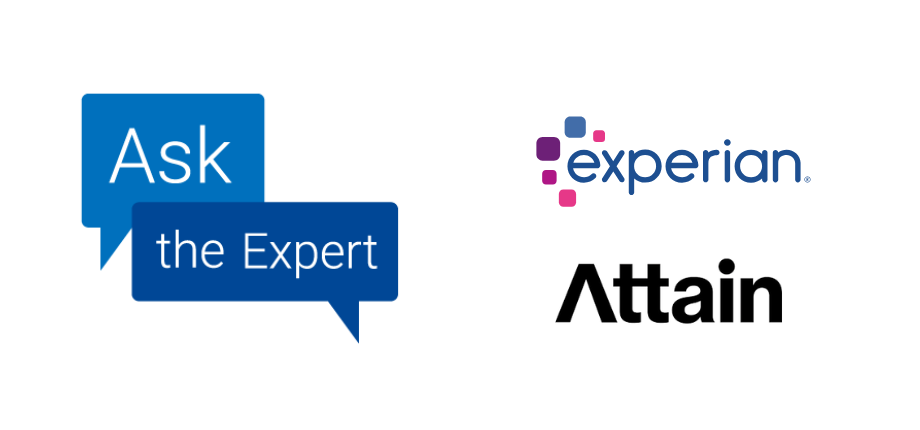
In our Ask the Expert series, we interview leaders from our partner organizations who are helping lead their brands to new heights in AdTech. Today’s interview is with Brian Mandelbaum, CEO and Co-Founder at Attain. About Attain Built for privacy — with visibility across all retailers, verticals and purchases — Attain provides solutions for the modern marketer. Its real-time measurement and optimization solutions coupled with high-fidelity audiences and proprietary insights enable marketers to drive valuable business outcomes. The power of transaction-based audiences Attain’s real-time transaction data provides a 360-degree view of consumer behavior. What makes this approach more effective than traditional demographic or behavioral targeting? Attain is the industry’s most trusted source of live purchase data, powered by a robust panel of 8 million fully permissioned consumers. Our platform delivers unmatched, real-time visibility into consumer purchase behavior across retailers, industries, and payment methods. Marketers gain deep insights — such as in-store vs. online purchases, payment methods, purchase frequency, cart contents, and average transaction value — enabling more precise audience targeting and media strategies. With Attain’s rich, transaction-based data, marketers can optimize campaigns with direct, actionable sales signals. Ensuring data accuracy and relevance Attain curates audiences using real-time transaction data, but advertisers often ask whether this data is deterministic or probabilistic. Can you clarify your methodology, and if probabilistic, how do you ensure accuracy and representation across the entire US population? Our transaction data comes directly from the largest live purchase data panel in the U.S. Covering over 10,000+ merchants and $600B in cumulative spend, our dataset offers a complete and dynamic view of real-world purchase behavior. Using advanced machine learning, we scale this data to represent the entire U.S. population with unmatched accuracy, ensuring a balanced and unbiased reflection of consumer spending patterns. Our rigorous methodology eliminates outliers, continuously optimizing for precision and stability, so marketers can trust our insights for better targeting, measurement, and optimization. Privacy-first data practices Attain is built on a privacy-first, consumer-permissioned model. There are many ways to capture purchase data—why did Attain choose a panel-based approach, and how does this method compare to other collection strategies in terms of accuracy, scale, and compliance? Attain’s panel-based approach is the foundation of our privacy-first, consumer-permissioned model. By capturing real-time transaction data directly from our opted-in consumer panel, we ensure unmatched accuracy and ethical data sourcing — paramount in today’s privacy-conscious world. In exchange for sharing their data, consumers receive valuable benefits like early wages, savings tools, and shopping rewards, with no hidden fees. Unlike legacy third party data providers, our directly sourced transaction data provides deeper, more precise insights, enabling highly granular and actionable audience segments. Our continuously growing panel reflects a broad cross-section of U.S. consumers while maintaining strict privacy and compliance standards. We fully adhere to regulations like CCPA and GDPR, giving both consumers and advertisers confidence in the responsible use of data. Attain’s approach delivers the ideal balance of accuracy, scale, and compliance—while prioritizing consumer trust. Cross-channel addressability With brands activating audiences across display, mobile, and CTV, how does Attain’s purchase data help advertisers refine their cross-channel strategies? Attain’s purchase data empowers advertisers to refine cross-channel strategies with smarter, data-driven insights. Our real-time transaction-based audiences enable scalable activation across display, social, online video, and addressable TV — ensuring campaigns reach high-intent buyers more likely to convert. By applying purchase-based audiences across all channels, marketers are utilizing the strongest signals possible, which enables a more effective holistic strategy to drive to that ultimate sales outcome. Whether through social media, TV/CTV, mobile, or programmatic platforms, Attain helps brands connect with consumers at key moments in their buying journey, maximizing media impact with real behavioral insights instead of proxies. With an expansive and growing network of media partners, Attain ensures brands reach their audiences wherever they are, delivering consistent, high-impact messaging. Whether optimizing for brand awareness or performance, our data helps marketers make smarter decisions to drive superior results. Proven performance with live purchase feedback Attain moves beyond traditional proxy metrics by providing live purchase data. How does this help advertisers optimize campaigns while they’re still running? What sets Attain’s audiences apart isn’t just the data fidelity and holistic coverage of consumer behavior, it's that they’re built and validated using live, privacy-safe purchase signals. Advertisers can execute campaigns confidently, knowing that they’re reaching real consumers based on recent, real-world transactions, not outdated models or inferred, probabilistic behaviors. Attain’s ability to measure sales lift across a wide range of inputs means that marketers can easily understand which audiences are driving actual sales outcomes during flight. This unlocks smarter mid-campaign optimizations, discovering new audiences, and fine-tuning targeting — to ensure audience performance continually improves against real revenue goals. Attain’s closed-loop approach gives advertisers a faster path from targeting to transaction, helping brands maximize the value of every impression. Industry-specific use cases Beyond CPG, Attain supports industries like QSR, retail, and financial services. Can you share a compelling example of how brands in these verticals are utilizing your audiences? Attain’s audiences provide a comprehensive view of the consumer, capturing all aspects of their purchase behaviors — from travel and dining to TV content consumption and shopping habits. This broad perspective offers brands a far richer set of buying signals than ever before, enabling them to make more informed decisions across the entire consumer journey. Quick service restaurants (QSR): With a comprehensive view across all transaction types (cash, credit, debit) – Attain enables QSRs to capture a full picture of customer spend at their nationwide locations. Ensuring these brands have holistic coverage across all sales channels, powered by a direct relationship with the consumer, Attain captures transactions both in-store, online, and through 3P delivery apps like UberEats and Grubhub. This powers Attain’s deep insights, which QSRs can use for intelligent, precise targeting- including frequent visitors, competitive share, products purchased, and more. QSRs can use this data to solve a variety of business objectives, like retention/growth, competitive conquesting, and more. Retail: In retail, Attain provides a wide range of audience segments, including loyalty shoppers, in-market buyers, competitive shoppers, and even adjacent buyers who may be interested in similar products. By combining these segments, retailers can optimize their campaigns to target real-time shoppers with the highest intent, rather than relying on outdated or generalized profiles that other providers might offer. Additionally, with our industry-leading refresh rate, brands benefit from the most up-to-date data, ensuring their campaigns are always aligned with the latest consumer behaviors. Financial services: In the financial services sector, Attain’s purchase data helps identify consumers who are actively considering financial products such as credit cards or loans. By understanding their purchasing behaviors, marketers can deliver highly personalized and relevant offers to those already displaying intent, leading to better conversion rates and more effective acquisition strategies. Integration with Experian's marketplace Attain is now available through the Experian marketplace. How does this integration make it easier for advertisers to activate and scale your audiences? Attain’s integration with Experian marketplace makes it easier than ever for advertisers to activate our purchase-based audiences across TV, social, and programmatic. This partnership makes Attain’s data even more accessible, supporting our mission to build the most comprehensive and trusted consumer data ecosystem. With direct access to our real-time audiences within Experian’s marketplace, advertisers can more efficiently launch campaigns at scale and make more precise, data-driven decisions. As one of Experian’s inaugural partners, we’ve already seen strong adoption and demand, reinforcing the value of this partnership. The future of transaction-based targeting As the use of transaction data in advertising continues to grow, what changes do you anticipate in how brands will apply it for targeting and measurement? And how is Attain evolving its approach to support those shifts? As transaction data reshapes advertising, brands can shift from targeting probabilistic audiences to reaching high-intent consumers for greater ad relevance and conversions. Purchase data also unlocks highly accurate incrementality measurement, closing the loop and revealing which tactics and channels drive true incremental sales. Attain’s platform is built for outcomes-driven advertising, capturing data across the entire media cycle to continuously optimize performance. As we continue to make investments in AI and machine learning into our platform, our insights will become even more actionable and efficient — helping brands maximize impact, drive incrementality, and fuel long-term growth. Thanks for the interview. Any recommendations for our readers if they want to learn more? To explore our audience segments, visit the Attain website or contact your Experian account representative to schedule your free match test. Contact us today About our expert Brian Mandelbaum, CEO and Co-Founder, Attain Brian Mandelbaum, a veteran entrepreneur and investor, is the co-founder and CEO of Attain, North America’s largest opt-in purchase platform. Prior to Attain, Brian founded Clearstream TV, a data-enabled video distribution platform acquired by Engine Group in 2015. He brings over 20 years of experience in data-driven digital media, collaborating with top agencies and major brands. Latest posts
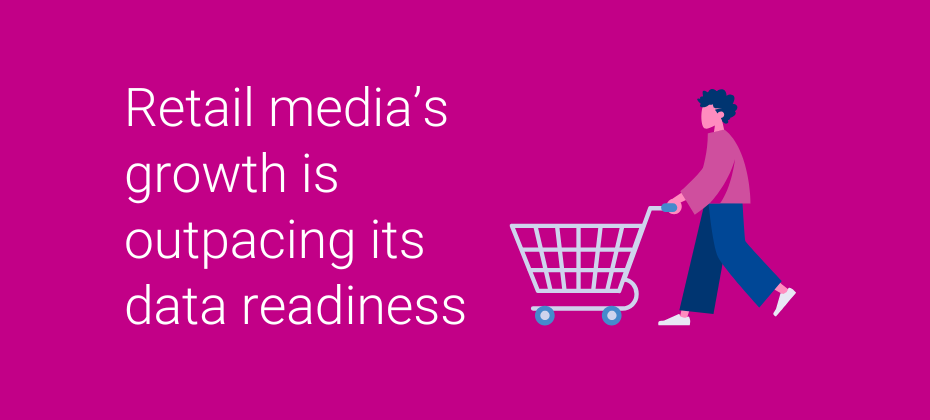
Retail media networks (RMNs) are on track to capture over $128 billion in ad spend by 2028, growing nearly 25% year over year. But behind this rapid expansion, RMNs face a challenge that could slow their momentum: they lack the complete picture of their customers. Retailers sit on a goldmine of first-party data—loyalty programs, online purchases, and in-store transactions—but their customer view is often fragmented, incomplete, or entirely anonymous. Without a strong identity foundation, RMNs struggle to: Scale advertiser reach beyond logged-in users Seamlessly match audiences across channels (CTV, programmatic, social) Deliver the precise targeting and measurement that advertisers demand The reality? Data is only valuable if it’s usable. And right now, too many RMNs are leaving value on the table. The identity challenge: If you can’t see it, you can’t monetize it Retailers have two types of customers: Known customers: Logged-in or self-identified users with purchase history and identifiable attributes. Unknown customers: Shoppers who browse, purchase in-store, or check out as guests—leaving behind only partial or anonymous data. Although many retailers have a loyalty program, it’s unlikely they are capturing a full view of all of their customers, especially outside of their four walls. When retailers don’t know their customers, they can’t effectively: Understand what messages will resonate with what audiences Extend their audiences beyond their owned platforms Provide advertisers with the reach and addressability they demand Accurately measure media performance and prove ROI But this challenge isn’t unsolvable—it’s an identity problem, and Experian is built to fix it. The missing link: Clean, enriched, and connected data Assuming your data is ready to activate is a costly mistake. Too often, RMN data is messy, siloed, and incomplete, making it difficult to deliver the precision and performance advertisers expect. Experian flips the script—helping RMNs transform fragmented signals into a complete, connected picture of their audience. Here’s how Experian helps RMNs go from fragmented to first-class Clean and optimize We organize messy customer data, removing duplicates and filling in gaps. Enrich and enhance Our insights add depth to profiles with demographics, behavior, and purchase intent signals. For example, an RMN may know a shopper recently bought a car seat—but not that they lease a luxury SUV. That auto data is critical to securing auto ad dollars, and it’s exactly the kind of insight Experian provides. Expand and connect Using digital identifiers like hashed emails (HEMs), mobile ad IDs (MAIDs), and connected TV (CTV) IDs, we help extend audience reach across every channel advertisers care about. The result? A complete and addressable audience picture that RMNs can activate confidently—on-site and off. We partnered with one of the largest RMNs in the world to overhaul its first-party shopper data ahead of industry changes. By anchoring its data to stable digital IDs, addressability skyrocketed by nearly 300%. That’s the Experian difference—turning guesswork into confidence. Retailers who master identity will win the RMN race In an increasingly competitive RMN landscape, identity isn’t optional—it’s everything. Advertisers demand scale, accuracy, and measurable impact. Only RMNs with a robust identity foundation will rise above the competition. RMNs that prioritize identity resolution and data enrichment will: Drive more revenue by increasing the size of their addressable audience Keep advertisers engaged with better targeting and measurement Capture RMN market share by offering scale and accuracy Don’t just compete—lead. Ready to transform? Experian will show you how Fixing data inside the RMN ecosystem is just the beginning. In part two, we’ll cover: Why RMNs should be activating their enriched first-party data across CTV, programmatic, and social. Why off-site expansion is the future of maximizing revenue. How Experian’s data and identity solutions power off-site activation. Experian isn’t just part of the RMN conversation. We’re driving it. Let’s talk. Connect with our team Latest posts
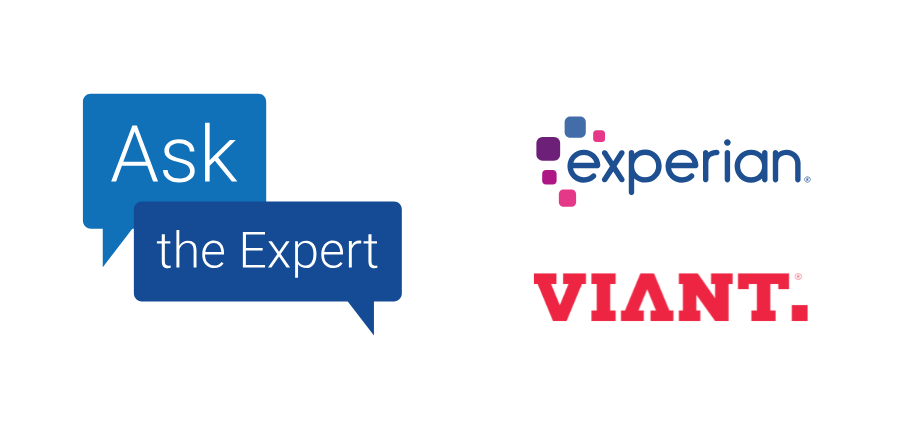
As privacy regulations, signal loss, and consumer expectations change, marketers face growing challenges in creating meaningful connections. In our latest Ask the Expert segment, Tom Wolfe, SVP at Viant, and Ali Mack, VP of AdTech Sales at Experian explore how first- and third-party data strategies, advancements in connected TV (CTV), and AI tools empower marketers to build smarter campaigns tailored to modern demands. Identity-driven advertising built on first-party data With the decline of traditional third-party signals and the rise of privacy-first advertising, first-party data is more important than ever. By collecting data directly from customers, marketers ensure they have accurate, user-consented data to fuel personalized advertising. Viant’s identity graph takes these first-party signals—such as email addresses, household locations, and phone numbers—and connects them with additional attributes in a privacy-safe way. This approach empowers marketers to build precise audience segments without relying on cookies, which Viant phased out over a decade ago. Combining first-party data and privacy-first solutions to build trust By combining first-party data strategies with privacy-first solutions, marketers can build long-term success while earning consumer trust. The Viant Household ID eliminates reliance on cookies while enabling secure, compliant campaign management. Additionally, Viant's partnerships with cleanrooms further protect their clients' data integrity and ensure smooth collaboration between trusted parties. Beyond safeguarding consumer information, the Viant ecosystem allows their clients to integrate data seamlessly from audience segmentation to campaign activation and reporting. How first and third-party data work together While first-party data is crucial for precise, personalized advertising, it isn’t always sufficient—especially for smaller or emerging brands that haven’t yet amassed audience data. Third-party data plays a pivotal role in these scenarios by supplementing first-party insights, offering a broader view of consumer behavior, leading to new growth opportunities. Viant collaborates with partners like Experian to help marketers seamlessly merge their customer information with additional consumer insights. Viant and their clients benefit from Experian's identity data to match various identifiers such as hashed emails, device IDs, or other platform-specific tags and map them back to a single consumer profile. With a unified view of the consumer, marketers can refine targeting, expand their reach, and maintain consistency across channels. By utilizing first- and third-party data solutions, marketers can build well-rounded, effective campaigns that resonate with diverse audiences. “Our clients have embraced the Viant Household ID because it powers a comprehensive, seamless flow from segment creation to targeting, activation, and measurement.” Tom Wolfe, SVP Business Development, Viant CTV as a core marketing channel CTV is emerging as the core platform for immersive and effective advertising by merging the visual storytelling power of traditional TV with the precision of digital tools. Viant helps marketers optimize CTV capabilities by building connections between premium publishers and data, allowing marketers to personalize experiences. Whether it’s tailored ads for families watching a live sports event or pinpointing niche interests, CTV enables marketers to reach diverse audiences with meaningful ads. Beyond awareness, Viant drives results for their clients and monitors that performance across each stage of the funnel. Marketers can use the key insights to optimize their media buys on CTV and achieve even higher ROI. Viant takes CTV performance a step further with its direct access programs. Stronger data matching via publisher partnerships improves accuracy, helping marketers connect with their ideal audience. Viant’s recent data shows that campaigns incorporating CTV achieve a conversion rate of 12.89%, outperforming campaigns lacking it by a wide margin. This dramatic improvement highlights the power of precise targeting combined with Viant’s advanced CTV tools. For marketers, this translates to impactful storytelling supported by tangible results. “CTV drives high-level brand awareness via sight, sound, motion, and emotion, but it also powers activity through the funnel.” Tom Wolfe, SVP Business Development, Viant AI is streamlining marketing from start to finish AI is transforming advertising by automating tasks like performance tracking and audience segmentation, allowing marketers to focus on strategy and creativity. At Viant, AI is part of the company’s DNA, helping marketers drive more efficient and effective campaigns. With real-time data insights and streamlined processes, teams can quickly refine messaging and optimize budgets. This efficiency not only saves time but also empowers marketers to channel their energy into creating impactful strategies that resonate with their audiences. The integration of AI into Viant’s ecosystem also simplifies overall workflows, optimizing campaign execution from start to finish. With performance tracking made easier and segmentation automated, marketers can rely on data accuracy and actionable insights to make confident decisions. How Experian and Viant work together Experian's syndicated audiences—demographic, auto, TV, FLA (Financial Fair Lending Act), and more—are available within Viant's platform. Experian's partnership with Viant enables the deployment of custom audiences specifically designed to meet distinct campaign objectives. Together, Experian and Viant provide solutions that support first-party data strategies, third-party data integration, CTV optimization, AI-driven insights, and identity resolution, creating a cohesive and privacy-forward marketing ecosystem. “At Viant, we focus on the sensible, scalable, impactful opportunities.” Tom Wolfe, SVP Business Development, Viant Watch the full Q&A Visit our Ask the Expert content hub to watch the full conversation with Tom and Ali and learn more about Viant’s scalable identity solutions. Contact us About our expert Tom Wolfe, SVP Business Development, Viant As SVP of Business Development at Viant, Tom and his team forge strategic business partnerships that fuel the company's growth and business strategy. He is a seasoned industry veteran with more than 25 years of expertise in content distribution, advertising, and technology, particularly in CTV. Throughout his career, Tom has played a pivotal role in establishing and managing multiple businesses at major companies such as Roku, TiVo, YuMe, and Comcast. Additionally, he has provided valuable advisory services to organizations including VIZIO, Vice Media, and many others across the ecosystem. Tom holds a B.A. in Political Science from Lehigh University and has shared his knowledge as a guest lecturer at both New York University and Drexel University. Latest posts